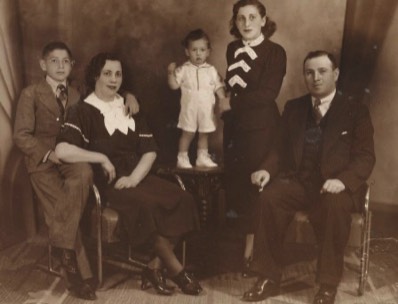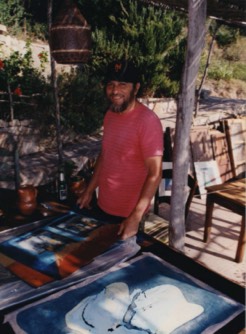
1936 – 1962
Born in Mexico City where he lived with his mother and extended family until the age of 6 when he and his mother moved to the United States to join family there. He first lived in Baltimore and then moved to New York. He became a US citizen in 1946.
Served In the US Navy after which the GI bill enabled him to enrol at the University of Washington in Bellingham where he studied anthropology and sociology.
Sam (standing) with his mother, aunt, uncle and cousin in Mexico City

In 1962 continued on to the University of Wisconsin to study, as his major area, sculpture under Leo Steppat. His intention had been that his minor area would be ceramics but on enrolling on the ceramics course he met some students who were there to enrol on the new glass course with Harvey Littleton. This exciting new programme caught his attention and he managed to persuade Harvey to take him on the glass course. His fellow students included Marvin Lipvosky, Michael Boylen, Rodger Lang, Bill Boysen and Pat Esch. He graduated with an MSA degree in sculpture and glass in June 1965.
Sam (centre) with fellow students Rodger Lang and Marvin Lipofsky

Sam Herman with one of his sculptures at the University of Wisconsin

Gained a Fulbright Scholarship to study at the Edinburgh College of Art under Helen Turner. During his time in Edinburgh he visited Stourbridge and the Royal College of Art and organised for an exhibition of the work of the students from Wisconsin to come to the UK to show at Edinburgh, Stourbridge and the RCA in order to show the colleges the exciting things that were happening in the US with the development of the small furnace. David Queensberry, head of the Ceramics and Glass Department at the RCA, saw the incredible potential of studio glass and invited Sam to become a Research Fellow at the RCA. Michael Harris was directly in charge of what was then called the Industrial Glass Department. He welcomed Sam with open arms and was instrumental in embracing the studio glass movement in the UK. At that time there was no concept with glass, as there was with ceramics, of the artist actually working with the material. Sam was about to change all that. In 1966 he built the first small tank furnace at the RCA, and headed the glass department there until 1974. He taught such future artists as Asa Brandt, Jane Bruce, Annette Meech, Clifford Rainey and Peter Aldridge to mention a few. Sam had the first ever exhibition of studio glass in the United Kingdom at the Primavera Gallery. He also was invited by the Czech Government on a tour of the Czech glass factories to exchange ideas with glass artists and designers there.
Above - working at Stourbridge College of Art
Below - working at the Royal College of Art


In 1969 set up the Glasshouse in Covent Garden with the help of Graham Hughes. The Glasshouse was intended as a staging post for students and recent graduates and a place where the public could watch glassblowing and purchase work.
In 1971 he had a prestigious exhibition at the Victoria & Albert Museum in London with the jeweller Gerda Flockinger. He also took part in the exhibition "Vrij Glas" (Free Glass) with Erwin Eisch, Marvin Lippofsky, Harvey Littleton and Sybrem Valkema which toured four European venues. He also gave workshops and teaching sessions at the University of California at Berkeley.
In 1973 he was one of the artists invited on a goodwill tour of Japan sponsored by the Crafts Council. Amongst the artists was the ceramic artist Bernard Leech.
Also during this period he did design work for Belgian glass manufacturer, Val St Lambert, along with other such designers as Philippe Starck, Yann Zoritchac, Borek Sipek, Frans Van Paaet, and Martin Szekely.
Above - entrance to the Victoria & Albert Museum exhibition

In 1974 was invited by the South Australian Government to set up the glass workshop at the Jam Factory in Adelaide. He was also invited on to the board of the Jam Factory.
The Jam Factory supports and promotes outstanding design and craftsmanship. Lived in Australia for five years exhibiting his work widely throughout the country while maintaining his commitment to the exhibitions in his European galleries.
Right - Conducting a workshop at the Jam Factory

1979 – 1984.
Returned to the UK to set up a studio in Lots Road, London with the initial support of Jonathan Stone and then John Campbell. This was an opportunity to concentrate solely on his glass work and for that reason was an incredibly productive period for this work. At his Lots Road studio he worked entirely alone thus having total control over every piece that was made there. In 1984 he decided to close the studio so that he could once again concentrate of non glass sculpture and explore more deeply his interest in painting.
In 1983 he became an Honorary Fellow of the Royal College of Art
Above - Sam at his Lots Road Studio

1984 – 1990
During this time he was very involved in the building of his home and studio on the north west coast of Mallorca and in developing his painting and returning to sculpture.
Also, in order to continue to have some contact with the world of glass he taught part time at the Buckinghamshire College of Art, heading up the glass department there until 1990.
In 1984 he become a UK citizen jointly with his American nationality.
Right - outside his Mallorcan house

Concentrated on painting from his studios in Spain and London, spending from May to November in Spain. Also acquired a sculpture studio in a village near his painting studio in Spain – an old mill which he has slowly been converting. During this period he also made a series of sculptural lighting pieces using metal and glass incorporating his own hand blown glass to obtain the colour and form he wanted.
Design work including work as a Consultant to Val St. Lambert
Left - on the terrace of his Mallorcan home

Had his first major exhibition of painting in Cork Street, London. Much of the work was very influenced by his time in Mallorca.
Continued to divide time between Mallorca and London

Returned to making glass for an exhibition at the Adam Aaronson's Zest Gallery in London. This was the first time he had worked with glass for 23 years and was a welcome return both for himself and for his collectors.
Working at Aaronson Noon for Zest Gallery Exhibition

2012 was the 50th anniversary of the launch of the studio glass movement in the United States - the initial workshops that led to Harvey Littleton setting up the glass course at the University of Wisconsin of which Sam Herman was one of the first students. To celebrate the occasion Sam Herman returned again to the furnace, both at Peter Layton's London Glassblowing (working with Layne Rowe) and at Colin Hawkins' studio in Cirencester (working with Richie Alli).
Working at London Glassblowing

Concentrated on sculpture both to be cast in bronze and combining flat glass with bronze or steel, incorporating some into lighting pieces. Continued to paint in the Spanish studio and to occasionally work in glass with Colin Hawkins at his Loco Glass studio in Cirencester.

In 2019 Lund Humphries published a book edited by Rollo Campbell entitled "Sam Herman" with an introduction from the Marques of Queensberry and contributions from Lucy Abel Smith, Michael Boylen, Mark Hill, Greg Votolato and Michael Regan. The book was launched at a retrospective exhibition at the Frestonian Gallery in London.
